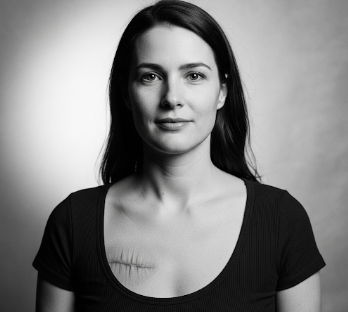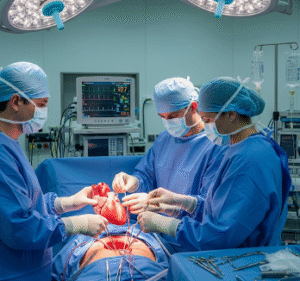What it is
A mastectomy is a surgical procedure to remove one or both breasts, typically to treat or prevent breast cancer. The surgery can involve:
- Total (simple) mastectomy: Removal of the entire breast tissue, including the nipple and areola.
- Modified radical mastectomy: Removal of the breast along with axillary lymph nodes.
- Skin-sparing or nipple-sparing mastectomy: Retains most of the skin or nipple for reconstructive purposes.
Key points:
- Performed to treat breast cancer or prevent its development in high-risk individuals.
- Can be combined with breast reconstruction either immediately or later.
- Considered a definitive treatment for certain breast cancer types.
Why it’s done
Mastectomy is indicated for:
- Breast cancer treatment: Especially for large tumors, multifocal cancer, or recurrent disease.
- High-risk patients: Women with BRCA1/2 gene mutations or strong family history.
- Failed breast-conserving surgery: When lumpectomy is not sufficient.
- Preventive (prophylactic) mastectomy: Reduces risk in high-risk individuals.
Note: The decision depends on cancer stage, tumor size, patient preference, and genetic risk factors.
Alternatives
Other treatment or prevention options include:
- Breast-conserving surgery (lumpectomy): Removes tumor but preserves breast tissue.
- Radiotherapy: Often combined with lumpectomy for local control.
- Medication-based prevention: For high-risk individuals (e.g., tamoxifen).
- Active surveillance: In select cases of very early-stage or low-risk tumors.
Important: Mastectomy provides maximum risk reduction or treatment efficacy, especially in high-risk or extensive cancer cases.
Preparation
Preparation is essential for safety and optimal outcomes:
- Medical evaluation: Blood tests, imaging (mammogram, MRI), and preoperative assessment.
- Medication review: Stop blood thinners as advised.
- Consultation: Discuss type of mastectomy, reconstruction options, risks, and recovery.
- Preoperative instructions: Fasting 6–8 hours before surgery, showering with antiseptic soap.
- Psychological support: Counseling may help patients prepare emotionally.
Patient instructions:
- Arrange post-surgery support at home.
- Wear loose clothing for easy access postoperatively.
- Follow anesthesia and surgical team guidelines.
How it’s done
Mastectomy is performed under general anesthesia:
- Incision: Surgeon marks the breast and incision line based on the type of mastectomy.
- Breast tissue removal: Complete breast tissue is excised.
- Lymph node assessment: In modified radical mastectomy, axillary lymph nodes are removed.
- Drain placement: Small tubes may be inserted to prevent fluid buildup.
- Closure: Skin is sutured, and sterile dressings are applied.
Duration: Usually 2–4 hours, depending on type and reconstruction plan.
Recovery
Recovery involves both physical and emotional care:
- Hospital stay: Typically 1–3 days; longer if reconstruction is performed.
- Pain management: Medications control post-operative discomfort.
- Drain care: Drains are usually removed 1–2 weeks post-surgery.
- Activity: Light activity is allowed, but lifting or strenuous exercise is avoided for several weeks.
- Rehabilitation: Physiotherapy may be required for arm mobility and lymphatic drainage.
- Full recovery: Most patients resume normal activities within 4–6 weeks; emotional adjustment may take longer.
Benefits:
- Removes cancerous tissue or reduces cancer risk.
- Provides a definitive treatment in high-risk or advanced cases.
- Can be combined with reconstructive surgery for improved cosmetic outcomes.
Complications / Risks
Mastectomy carries potential risks:
- Infection or bleeding at the surgical site.
- Seroma or hematoma formation.
- Numbness or tingling due to nerve involvement.
- Lymphedema: Swelling in the arm after lymph node removal.
- Delayed wound healing or scarring.
- Psychological impact: Emotional distress or body image concerns.
Prevention / Management:
- Performed by experienced breast surgeons.
- Postoperative care, wound monitoring, and rehabilitation programs minimize risks.
- Emotional and psychological support is recommended.
Treatment Options in Korea
Mastectomy is widely available in Korean hospitals and specialized breast cancer centers:
Key features:
- Performed by experienced oncologic and breast surgeons.
- Options include total, modified radical, skin-sparing, and nipple-sparing mastectomy.
- Reconstruction can be done immediately or delayed using implants or autologous tissue.
- Comprehensive care includes preoperative counseling, surgery, and postoperative rehabilitation.
- Advanced facilities provide support for both physical and psychological recovery.
Summary: Mastectomy in Korea is a safe and effective surgical option for treating or preventing breast cancer. With modern surgical techniques, reconstruction options, and expert care, patients benefit from high-quality treatment, reduced cancer risk, and improved quality of life.













